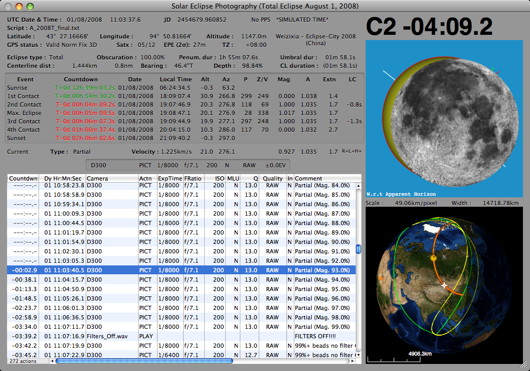

- #SOLAR ECLIPSE MAESTRO EOS R HOW TO#
- #SOLAR ECLIPSE MAESTRO EOS R INSTALL#
- #SOLAR ECLIPSE MAESTRO EOS R MANUAL#
- #SOLAR ECLIPSE MAESTRO EOS R ISO#
- #SOLAR ECLIPSE MAESTRO EOS R SERIES#
The idea that you'll nail all this the first time through is. BTW, the timing of some of these shots is critical (Baily's Beads is a fleeting effect and the camera literally has to grab that shot in in the right fraction of a second or it'll be missed.) is have your head stuck looking at the back of your camera while you frantically try to work out all the expousures settings you need and keep moving the tripod to keep the sun framed in the middle - and miss witnessing all these amazing phenomena. There are phenomena with the sounds, the wind, the temperature, the behavior of animals. and then a few minutes later to see it racing away. being able to see the moons shadow racing toward you. shadow bands, the diamond ring, baily's beads, the solor corona, the 360º sunset, and if you're on high ground.

There are so many cool things that are going to happen. if this is your FIRST "total" solar eclipse, don't photograph it. The most experienced eclipse experts I know all give the same advice. but I think you just just enjoy the event and not include the camera. At the end I'll offer you some exposure info if you really want to do this. I'm going to try to talk you out of the idea of photographing this. I'm going to give you a completely different perspective. To practice for the totality phase, you might want to wait until the sun is setting, the lighting condition will be similar to that.

No other thinking is involved and it's very doable. Remember, in my scheme, after you set Av and ISO, all you have to do is to change the Tv dial until things look right on the LCD.
#SOLAR ECLIPSE MAESTRO EOS R ISO#
So when the moon starts to touch the sun, you might want to change the Av to f/5.6 and ISO to 800 so that the shutter speed does not take overly long. The camera can only handle 30 seconds and you don't really want to open it up too long so I think I need to rethink this a bit. You know.for the totality phase.my settings may cause the shutter speed to be too long.
#SOLAR ECLIPSE MAESTRO EOS R HOW TO#
What you said has made it more clear on how to do the settings. I understanding helping beginners can be a huge pain and I appreciate your help. I know a little about the camera but I haven't played around with it a lot and a lot of the articles I have read has said different things some saying I needed the iso to 800 or more and the av to f5.6 - f8 and they didn't explain a lot about the different exposures. It's a lot more convenient to set off the shutter without touching the camera to avoid shaking the camera unnecessarily thus blurring the wrote: You should invest in a wired remote control for your camera. Practice it now until you get the procedure down pat. Actually I have never photographed the total eclipse myself. I witnessed the total eclipse in February 1979 but I didn't photograph it. I think at your beginner level, 300mm is better because the moon moves in pretty quickly,a higher zoom level will require you to move the camera to track it which might not be a good thing. You can also try to block the sun with something to get used to adjusting the Tv dial to get the right exposure. You can practice this on the regular sun until you get a perfect white circle with a darkened background. Again dial that Tv to get the right exposure (looks right on the LCD)

Reinstall the filter then continue to photograph the moon exiting. Two cameras set up is better because removing the filter is not that simple when you're very excited and it's almost completely dark out there.ĩ. When the moon almost completely covers the sun, you may need to remove the solar filter in order to get the white aura around the black moon.Once you remove the filter, you have to significantly change the Tv value to get the right picture on the LCD.
#SOLAR ECLIPSE MAESTRO EOS R SERIES#
Take a series of shots, each time adjust the Tv dial so it looks OK on the LCD.Ĩ. You don't really care what the values are. You need to turn the Tv dial until it looks right on the LCD screen. As the black moon starts to overtake the sun, the scene will get increasingly darker. You can adjust Tv until the dark background is dark but not completely black because you want the black moon to show also. Turn the dial to set the shutter speed (Tv) until you see an image.most likely dark background and a white circle where the sun is. Turn on Live View - there is a good chance it's completely dark on the LCD screenĦ.
#SOLAR ECLIPSE MAESTRO EOS R INSTALL#
Mount camera on a tripod, zoom to 300mm, install solar filter - point towards the sun and put the sun in the middleĥ. I usually don't advice this for beginners but for the purpose of photographing the solar eclipse you should be using M mode.ġ. there are only 3 things to need to set: Av, Tv, and ISO.
#SOLAR ECLIPSE MAESTRO EOS R MANUAL#
You need to read the manual to practice setting things and practice well ahead of time before the day comes. Are you saying you don't know how to work your camera at all? That will make it pretty hard for any of us to show you how.


 0 kommentar(er)
0 kommentar(er)
